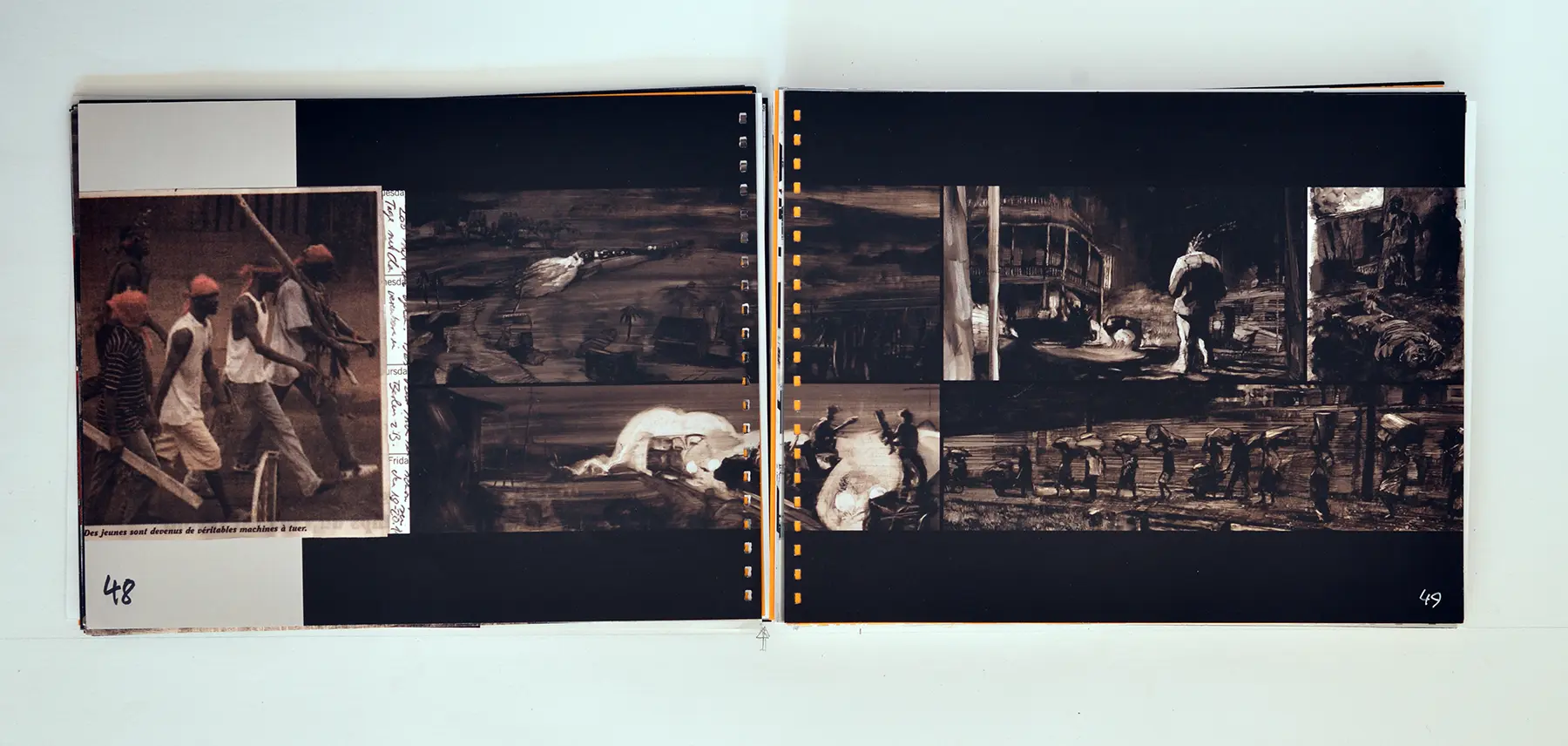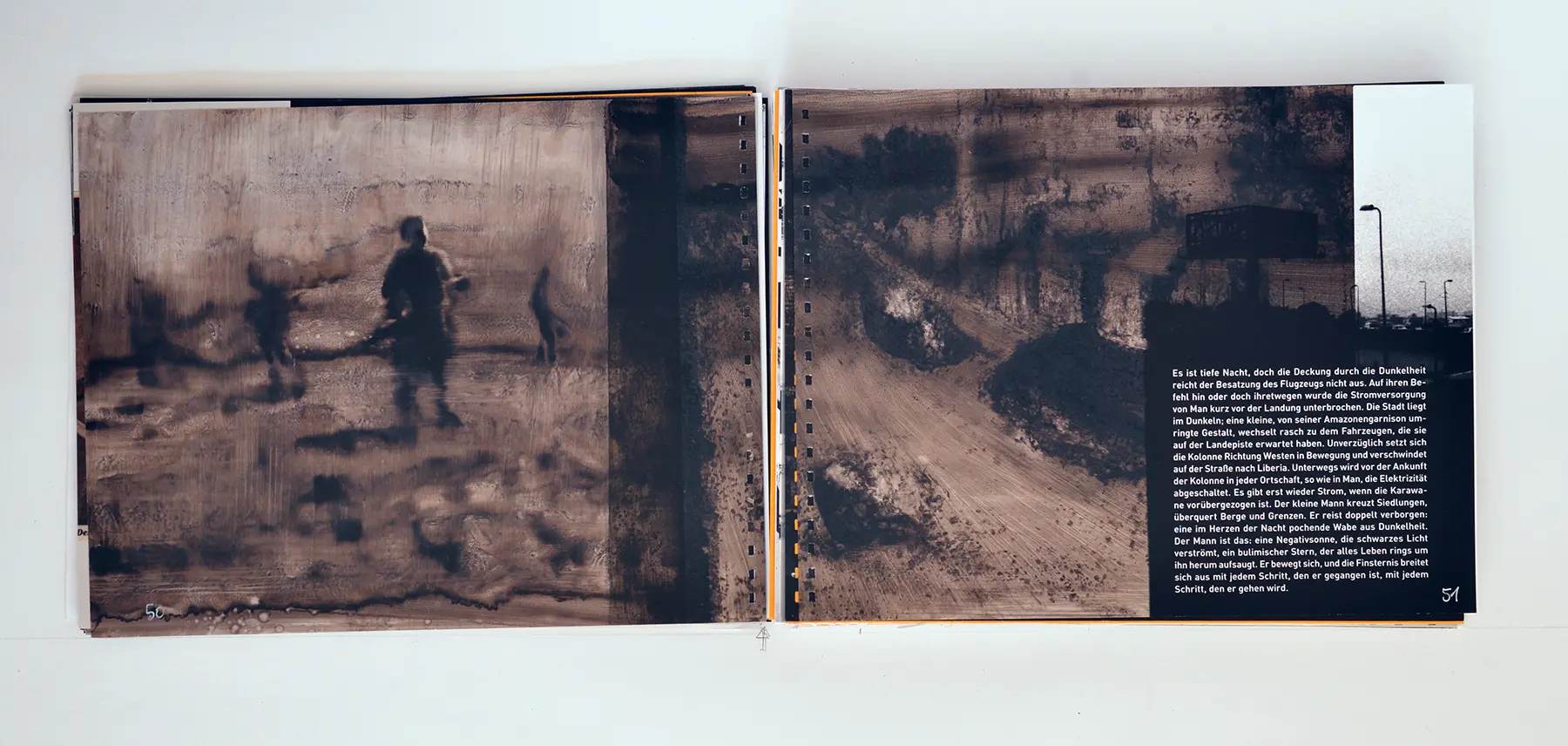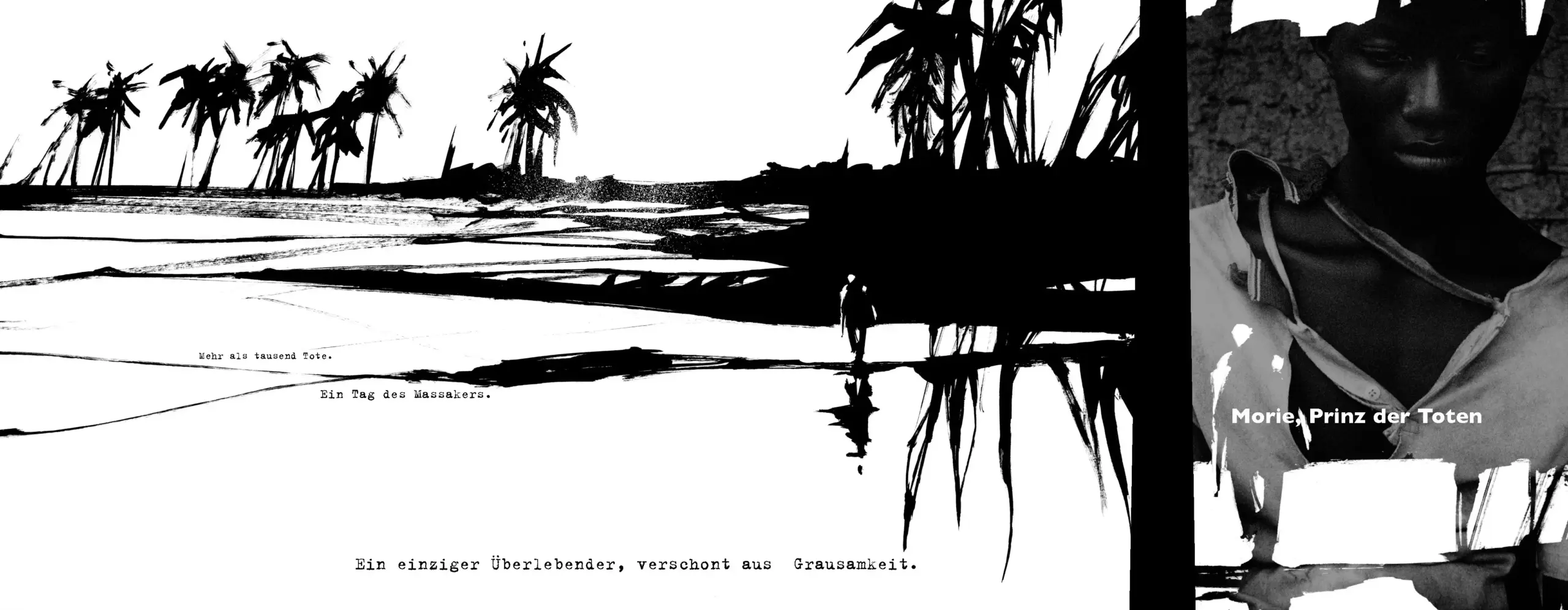Black.Light revisited


Blacklight is based on the reports by Pedro Mendes (text) and Wolf Böwig (image) on the Charles Taylor wars in Liberia and the rest of West Africa between 1996 and 2003. In 2012, graphic novelists used this as a basis to create several episodes about individual people and actions that impressively illustrate the destruction caused by Taylor’s warlord rule.
In the planned revisited version, reports and episodes will be expanded to include contributions in words and pictures from today’s perspective. They understand Blacklight as a prism of destabilizing and devastating conflicts of global significance that are embedded in larger contexts.
Habbo Knoch
01 Über Gewalt berichten
Illustration: George Pratt | Text: Pedro Rosa Mendes | Foto: Wolf Böwig | Layout: Christoph Ermisch
16 Doppelseiten
One night in Florida: The opening essay for BlackLight is an intimate reflection about war reporting. The foundational idea for BLP was documenting on the ground the civil wars in Liberia, Sierra Leone and Côte d’Ivoire. That program was delivered in fragments of reportage, each opportunity re-invested in the next field assignment. All the while, the authors kept their eyes on the prize: BLP`s running thread is about the brutal forms and layers of violence against civilians in those wars. This essay puts in perspective the mechanism by which reporting with empathy inevitably pulls the reporter to communion in that pain. Let us then start the journey. It´s late night at the miserable hotel Florida and darkness reaches us from all corners of Monrovia. All demons are here, we marshalled them all day, all week. It´s our routine, devotedly. “What a world”. There´s destruction everywhere; worse, there´s desecration in everyone. It gets to us. “The nails, the spear, and man’s un – pity – ing scorn.”
02 Operation no living news
Text: Pedro Rosa Mendes | Collage: Wolf Böwig
2 Doppelseiten
03 Schwarze Sonne
Text: Pedro Rosa Mendes | Illustration: Thierry van Hasselt | Foto: Wolf Böwig | Layout: Christoph Ermisch
6 Doppelseiten
Black Sun: People in Man, Côte d’Ivoire, knew when Charles Taylor would transit through this rear-base during his bush wars: lights would go off across the city. The blackout would then follow the warlord westwards, enveloping his motorcade as Taylor headed to Nimba County across the border with Liberia. Who´s this master of darkness? A black sun radiating negative light. Darkness expands as he conspires and orders to kill, plunder, enslave and destroy for his gain.
04 Dasia: als ich hierher zurück kam …
Interview mit Dasia | Transcript: Pedro Rosa Mendes | Illustration: Stefano Ricci | Zeitungsausschnitte | Layout: Christoph Ermisch
3 Doppelseiten, zum Teil auf Transparent
Dasia: When I first got here: A master course by Dasia Masaquoi– in memoriam! Dasia, a retired mining engineer turned “real estate agent”, lectures with eloquence and analytical rigour the process of moral unravelling behind the destruction of Liberia. This is a spoken essay, collected and edited from several encounters with Dasia, walking down Broad Street in Monrovia. His memories, his despair, his faith, his humanity, his fury – in his own words. “You see fear. Raw fear. And that raw fear is turned and transcended into power. This violence, you go into it and you don’t question yourself again.” His hope, still; like a boy with a happy dime in his pocket. So speaks the victim…
05 Peanut Butter
Text: Pedro Rosa Mendes | Illustration: David von Bassewitz | Foto: Wolf Böwig | Layout: Christoph Ermisch
9 Doppelseiten
I will play a movie: Are we “in the wrong place at the wrong time”? That´s how, years later, Senator Adolphos Dolo, aka General Peanut Butter, would explain to the Truth and Reconciliation Commission how he ended up as one of Taylor´s most loyal and commanders. When we fell into his hands, coming from LURD controlled areas across St. Johns River, Peanut Butter was the last man standing: a general contemplating defeat, encircled in the forest up in Nimba with his army of child soldiers. “They’re not real children. These types have seen their family killed before their eyes and the ones who killed them didn’t even bother to take them away. Sometimes I can only think that I’m going to lose my mind. Why do I have to be here?” Eloquent oral history, political history, moral history, So speaks the perpetrator…
06 Matrioschkas + In our Hands [ Joshua Craze ]
Text „Matrioschkas“: Pedro Rosa Mendes | Text „In our Hands“: Joshua Craze | Foto und Collage: Wolf Böwig | Layout: Christoph Ermisch
20 Doppelseiten
Matrioschkas: The battle cry of the rebels in Sierra Leone during the advance on Freetown in January 1999 had a terrifying simplicity about it: “No Living Thing”. A human being was not worth living, or did not ask for more remorse, than a chicken, a dog, a goat, perhaps because each soldier was previously turned into a beast, emptied of any values considered vaguely human. Or the combatants were even prevented for learning those values. It is the obvious case of the swarm of children caught in the war machine, of fighters methodically alienated by drugs, abuse or indoctrination.
07 Die Zone
Text: Pedro Rosa Mendes | Illustration: Nic Klein | Foto: Wolf Böwig | Layout: Christoph Ermisch
9 Doppelseiten
The Zone: Behind the frontline with Abu Musa Keita, aka Commander Alpha Mike from LURD. There´s little left from Gbarnga, a strategic outpost in LURD`s advance towards Monrovia. “Careful, get his weapon!” Alpha Mike rules over a town in the edge with drunken and drugged teen soldiers. „Get out of here! You listening or do I shoot you?” What´s left to reconstruct? From the rubble, people make the triage by hand: bricks in one pile, window frames in another, wooden elsewhere for fire.
08 Dasia: Gott war gut zu uns
Interview mit Dasia | Transcript: Pedro Rosa Mendes | Illustration: Stefano Ricci | Layout: Christoph Ermisch
3 Doppelseiten, zum Teil auf Transparent
Dasia: God was good: Dasia´s reflection on live and let die. “God was good to us, you know? When the killing was on, it was dry. When it stopped, the rainy season would start to wash all the blood away.” Whose hands are to take justice?
09 Der Grieche Adamas
Text: Pedro Rosa Mendes und Marko Dinić
Foto: Wolf Böwig
3 Doppelseiten
Carbon exists in two basic forms in nature: diamonds and graphite. These are fundamentally different in how their respective crystal structures (the spatial disposition and linkages between atoms). Graphite forms in a hexagonal system, but the links or network between two parallel plans are extremely fragile: like a pack of cards, each card is strong, but the cards will slide over each other, or even fall off the pack. That´s why graphite is the stuff of pencils and brushes. In diamonds, by contrast, each carbon atom is joined to four other carbon atoms by strong covalent bonds. Diamonds are so hard due to the need to break very strong covalent bonds operating in 3-dimensions. In a war fought for diamonds, fighters in Sierra Leone carved “RUF” on the chests of civilians and amputated the fingers and/or hands of those who attempted to vote. Which calligraphy lasts longer?
Der Grieche Adamas
Kohlenstoff (chemisches Element C), die Grundlage des uns bekannten Lebens, kommt in der Natur im wesentlichen in zwei Formen vor: als Diamant und als Graphit, von Schreibern und Zeichnern gemeinhin als „Kohle“ bezeichnet, da man mit ihr schreibt. Der grundlegende Unterschied zwischen Diamant und Graphit besteht in seiner Kristallstruktur, also in der Anordnung und den Verbindungen zwischen den Kohlenstoffatomen im Raum.
Nach einem gleichen Plan sind die Verbindungen beim Graphit sehr stark und symmetrisch zu einem Hexagon angeordnet (man sagt mithin, der Graphit kristallisiere in einem hexagonalen System), die Verbindungen zwischen den Atomen zweier paralleler Ebenen aber sind extrem schwach ausgeprägt.
Beim Diamanten dagegen sind die Atomverbindungen des Kohlenstoffs extrem stark, die Abstände zwischen den Atomen sehr kurz. Wichtig dabei ist, dass in der Struktur des Diamanten jedes Atom mit vier anderen Atomen verbunden ist, die sich an den Scheitelpunkten eines Tetraeders befinden. Diese Struktur heißt tetraedrische Koordination. Diese ganz eigentümlichen Verbindungen verleihen dem Diamanten außergewöhnliche physikalische und chemische Eigenschaften, was ihm seitens der griechischen Naturwissenschaftler den Namen adamas, der „Unbesiegbare“, eingebracht hat. Der griechische Ausdruck bildet den Ursprung des lateinischen adiamantum und des portugiesischen diamante.
Die räumliche Anordnung und Wiederholung der Kohlenstoffatome in einem Diamanten ist in einer kubischen Symmetrie organisiert (im Gegensatz zum Graphit, der wie gesagt in einem hexagonalen System kristallisiert). Dies ist die strukturelle Differenz, die diese beiden polymorphen Kohlenstoffminerale unterscheidet, Minerale mit der gleichen chemischen Zusammensetzung also, jedoch einer unterschiedlichen Kristallstruktur (und mithin unterschiedlichen physikalischen, chemischen, etc. Eigenschaften).
Es gibt noch eine weitere Modifikation dieses gediegenen Elements (als gediegene Elemente werden Minerale bezeichnet, deren Zusammensetzung aus einem chemischen Element besteht, im allgemeinen Gold, Silber, Platin, Schwefel), das Lonsdaleit heißt, in einem Hexagonalsystem kristallisiert und als Mineral äußerst selten ist. Es kommt in mikroskopisch kleinen Exemplaren vor, die sich in Gegenden mit sehr heftigen Meteoritenimpakten bilden, so wie in Tonguska in Russland im Jahr 1908. Diese seltene Modifikation erhielt ihren Namen zu Ehren der Kristallographin Kathleen Lonsdale.
Aus der Kristallstruktur des Graphits resultiert eine Brüchigkeit, die Spaltbarkeit genannt wird; aufgrund eben dieser Spaltbarkeit zersplittert Graphit so gut in verschiedene Richtungen. Das erlaubt seine Verwendung auf dem Papier, in von zahllosen, gespaltenen Graphitteilchen gebildeten Linien.
Nach unserer Ankunft gingen wir auf den Markt. Ich kaufte das, was ich normalerweise als erstes benötige: ein Heft und einen Bleistift.
11 Mikado
Text: Pedro Rosa Mendes | Illustration: Dieter Jüdt | Foto: Wolf Böwig | Layout: Christoph Ermisch
7 Doppelseiten
Mikado: Desecration is also about violating nature, logging where ancestral spirits inhabited ancestral forests. North of Parallel Nine, in Northwestern Côte d’Ivoire, illegal logging and timber smuggling feed both the regional war economy and the global appetite for exotic wood. The hostilities against civilians start with a war against forests´ ecological, cultural and spiritual value. Follow the prospector. He´ll guide us to the tallest tree: it´s a sacred century old. You need many men to fully embrace those 100 years. It´s all brought down in few minutes, with the guttural noise of a dying whale.
12 Der Glaube der Vögel
Text: Pedro Rosa Mendes | Layout: Christoph Ermisch
2 Doppelseiten
Birds of pray: How brave is non-violent resistance when war is raging all around you. A group of women has held weekly ecumenical demonstrations for peace at the airport in Monrovia, defiant of artillery and shooting.
“What’ we want?” – “Peace!!!” “When?” – “Now!!!”
One woman, apart from the group, falls to her knees and lies prostrate on the ground, trembling in a quiet, dry weeping. She murmurs names, and the names drive her to despair.
“We women are natural peacemakers. We have overcome our differences, because we have all suffered from the same crimes,”
13 City of Rest
Text: Pedro Rosa Mendes | Illustration: David von Bassewitz | Foto: Wolf Böwig | Layout: Christoph Ermisch
7 Doppelseiten
City of Rest: An evangelical pastor opened this house in Freetown to those drowned into addition during the war. “There are Rastas, druggies, hippies, junkies, dreads, soldiers, rebels, thieves, murderers–” They cleanse themselves through gospel but there´s no other palliative: they are chained to bed frames and poles for the average purge of four to six weeks. “This is hard, man. People aren’t born to be in chains,” There´s a commotion outside, a procession approaches the gate: another escapee, chained to a metal chair, is brought back to God. Salvation is hell.
14 50 cent
Text: Pedro Rosa Mendes | Layout: Christoph Ermisch
1 Doppelseite

50 Cent: Rape, sexual slavery, outrages upon personal dignity, violence to life, health and physical or mental well-being, in particular cruel treatment, are crimes against humanity. Civilians were primary targets in Taylor´s wars; women and girls paid the heaviest price, and the legacy unfolds long after the hostilities. ”Elle est malade…”
15 Die Liebe zur Freiheit
Text: Pedro Rosa Mendes | Layout: Christoph Ermisch
2 Doppelseiten
Die Liebe zur Freiheit: Kofi Woods, a leading voice among Liberian human rights defenders, speaks from exile in Sierra Leone about accountability, reconciliation, and closure if Liberia is to build a peaceful future. Woods is also unsparing about the roots of social and political violence in a settler/colonial society. On how hatred festers in ethnic and social segregation. “The love of liberty brought us here”? The Liberian anthem should be, “The love of liberty met us here”.
16 Neu: Text [ Habbo Knoch / Tessa Hesener ]
Text: Tessa Hesener
1 Doppelseite (geplant)
+ Text von Habbo Knoch
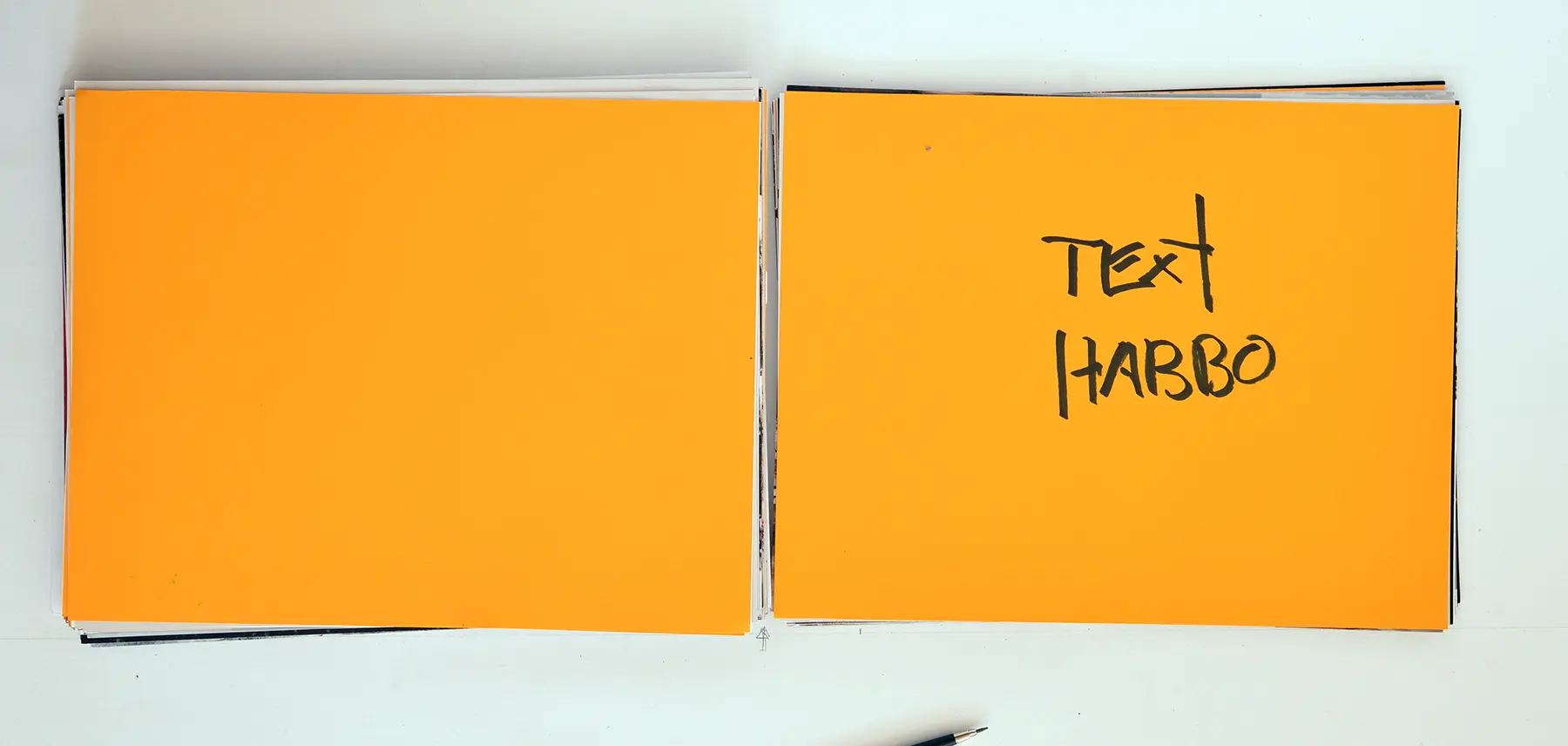
17 Mein Traum war
Text: Pedro Rosa Mendes | Illustration: Benjamin Flao | Foto: Wolf Böwig | Layout: Christoph Ermisch
12 Doppelseiten
My dream was: Amputees are an ugly, literal memory of the horrors of the war in Sierra Leone. Many preferred to exile them out of sight, out of town. In the Bombuna Mountains, in a remote ghetto for amputees. Balá Cissé knows how to drink water as dogs do, “just with my mouth.” Cissé was shoved against a fence, where rebel fighters extended his arms on top of the wood. And the saber came down twice. “God made me a man. God took me back to my childhood.”
18 Dasia: Das gute Gemetzel
Interview mit Dasia | Transcript: Pedro Rosa Mendes | Illustration: Stefano Ricci | Zeitungsausschnitte | Layout: Christoph Ermisch
6 Doppelseiten, zum Teil auf Transparent
Dasia: The right bloodshed: Dasia’s moral trajectory comes down to one psalm of his own: if the blood of one man prevents the blood of a thousand, that’s the right bloodbath. Were he younger, boy would he be bad. “I want blood for blood. I don’t want justice.” A challenging closing argument that brings down the aspirations of reconciliation and moral high ground against the political economy of justice: justice is also a function of individual liberty and voice. You need a civic critical mass for that.
19 Neu: Text [ Susana Moreira Marques ] + Collage
Text: Susana Moreira Marques | Collage: Wolf Böwig
3 Doppelseite (geplant)
+ Text von Susana Moreira Marques
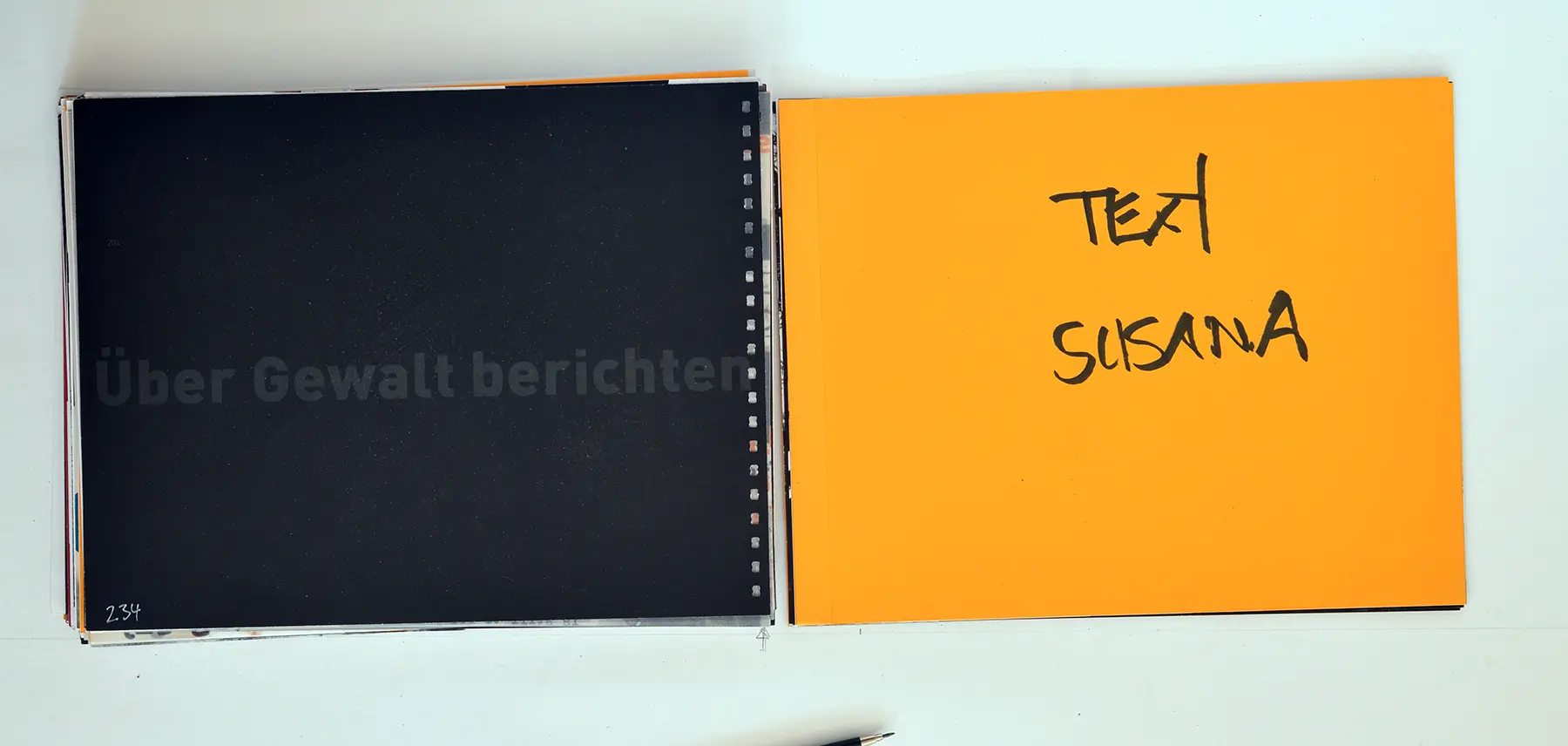
…
At home, as I look at images of victims and perpetrators, of silent women and fearless girls, of old men who’ve seen too much war for too long and boys who have fought the hardest imaginary battles – images of strangers, reporters and photographers insist in bringing close to us – the problem is not the feeling that I don’t know them at all but the feeling that I know them too well. I imagine too easily what moves them. There’s no longer need to ask the question, hear the answer.
The dream of a house with a garden
The dream of quiet love in a house with a garden
The dream of money to buy things to give to loved ones
The dream of things that will finally make one look like one feels
The dream of remembrance; that is, not to be forgotten once no more stories can be told
The dream of importance, that something would have been less beautiful, less interesting, less useful if it weren’t for one person
The dream of children, so similar to their parents and yet, different, the dream children will be so much better as they grow up
The dream of moving, being recognised somewhere else
…
Hidden in plain sight,
a list of common dreams
Susana Moreira Marques
12|24
+ 3 Collagen [ Kontaktabzug ]

20 Morie, Prinz der Toten
Text: Pedro Rosa Mendes | Illustration: Danijel Žeželj | Foto: Wolf Böwig | Layout: Christoph Ermisch
7 Doppelseiten

Morie: Morie is the superlative in BLP: the “story” that sets and challenges the boundaries of humanity throughout the project. Morie was the only survivor of an all-day- long massacre of his entire village (1200 people). We traced the boy down in the swamps of Pujehun in 2003 and later we visited his teenager persona: the trauma lives on and came of age… “Here, in the middle of these stakes, were about 150 bodies,” the old man explains. “Shall we dig?”
21 Team etc.
Umfang: 3 Doppelseiten (geplant)
Finale Version Mai 2025
Wolf Böwig’s combination of image, art and word is exceptional. It allows multiple approaches to the humanistic dimension of suffering mass violence. The focus is not on the violence itself, but on the emptiness and destruction, but also on the resilience and will to survive of people who have become victims of international conflicts. Blacklight Revisited is about human dignity – it is a compelling offer to critically reflect on one’s own existence in the face of war and injury in post-colonial spaces of violence.
Habbo Knoch



